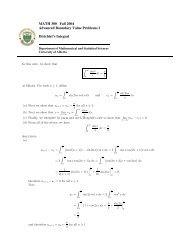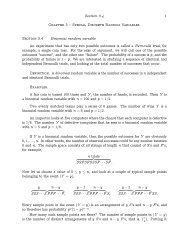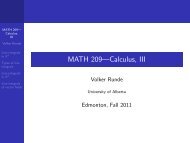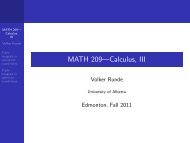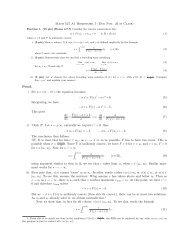Math 411: Honours Complex Variables - University of Alberta
Math 411: Honours Complex Variables - University of Alberta
Math 411: Honours Complex Variables - University of Alberta
Create successful ePaper yourself
Turn your PDF publications into a flip-book with our unique Google optimized e-Paper software.
Chapter 5<br />
Cauchy’s Integral Theorem and<br />
Formula<br />
Definition. Let D ⊂ C be open. If f : D → C is complex differentiable at each<br />
z ∈ D, then we call f holomorphic (or analytic) on D.<br />
Let z1, z2, and z3 be three different points in C. They span a triangle ∆. Its<br />
boundary can be parametrized as a curve with counterclockwise orientation.<br />
We denote this curve by ∂∆.<br />
∆<br />
z1 z2<br />
Theorem 5.1 (Goursat’sLemma). LetD ⊂ C be open, letf: D → C be holomorphic,<br />
and let ∆ ⊂ D be a triangle. Then we have<br />
�<br />
f(ζ)dζ = 0.<br />
∂∆<br />
Pro<strong>of</strong>. First, we note that the result holds trivially whenever z1, z2, and z3 are colinear.<br />
Otherwise, we can split ∆ at its medians into four subtriangles ∆ (1) , ∆ (2) , ∆ (3) ,<br />
and ∆ (4) as shown in the following figure:<br />
28<br />
z3



